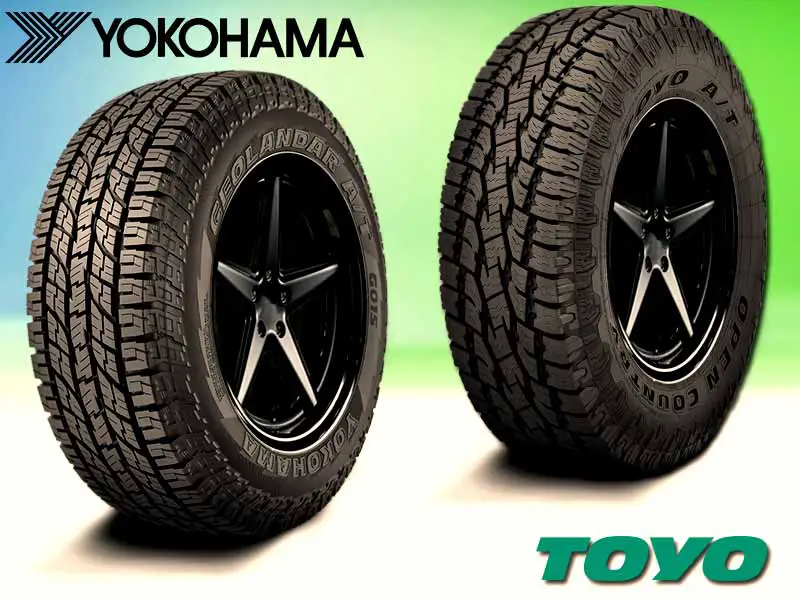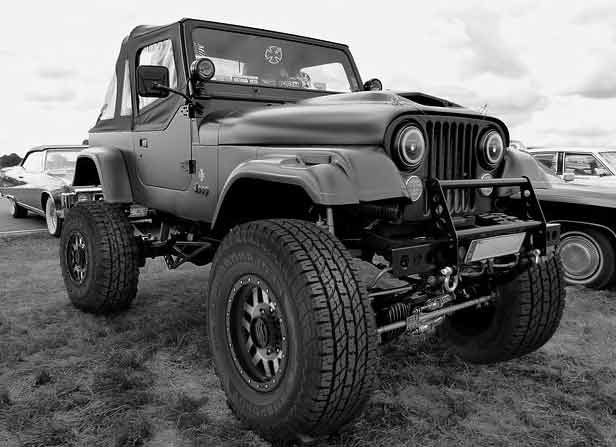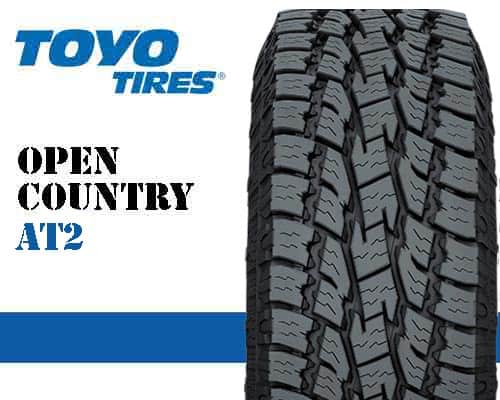Both the Yokohama Geolandar and Toyo Open Country are All-Terrain tires dedicated to offering excellent traction on and off the road.
The Yokohama GO15 shines on-road owing to its tightly packed tread blocks, and the Toyo Open Country AT2 (replaced by AT3 now) is better suited for off-road adventures for the reason that it has sparsely distributed tread blocks.

Because of its greater constructed strength and durability, the Toyo AT2 has an advantage over its competition whereas the GO15 has a three-peak mountain snowflake (3PMSF) rating assuring better performance in light snow and ice.
Let’s dive in. But first make sure you check out the differences between the Yokohama Geolandar G015 and G012. It would help things further.
Table of Contents
Side By Side Comparison
Yokohama Geolandar G015 Overview
The Yokohama Geolandar GO15 has a symmetrical multi-pitch tread variation design having four narrow but deep circumferential grooves cutting the tread into five segments.

The blocks in its tread are closely packed, allowing the greater part of it to simultaneously touch the ground.
As a result, it decreases the void ratio of this tire.
Wide lateral grooves form the shoulder lugs, giving an aggressive look to its shoulders.
The central blocks are divided by a step-shaped horizontal groove while the inboard and outboard tread blocks are divided by a vertical step-shaped groove.
The 3d sipes are available on both of these blocks in the pulsating variations of 1 to 2.
However, in the central blocks, two of these 3d inclined sipes are available but originated from the opposite direction on the alternating blocks.
Shoulder lugs have two deep straight sipes which are vertically connected.
It has decent stone ejectors installed in between its shoulder lugs.
Toyo Open Country AT2 Overview
Toyo AT2 has an aggressive tread block design with multi-pitch variation employing four wide circumferential groves cutting the tread into five parts.

The blocks in this tire are placed widely apart due to which a smaller area touches the ground at an instant which decreases its contact patch.
It has large shoulder lugs and its lateral grooves are very wide.
In the center, it has polygonal-shaped blocks which are far apart from one another.
The central column blocks have three zig-zag sipes two on the inboard and one on the outboard side.
The inboard and outboard column blocks have two parallel zig-zag sipes on each block present on the external sides.
Similarly, the shoulder lugs also have two parallel zig-zag sipes in the center.
It has tie bars available in between shoulder lugs and bold stone ejectors are also featured in this tire.
On-Road Traction Comparison
Because of its reduced void ratio, Yokohama GO15 is believed to be superior on the road, allowing for greater contact with a surface.
As a result, it has more grip and shorter braking distances.
(The tire even has a better grip than the Hankook Dynapro ATM and the General Grabber AT3)
When driving on wet roads, this tire’s small grooves and 3d sipes are less effective at sweeping away the water, rendering this tire unreliable on wet tracks.
Toyo A/T II features a larger void ratio, which means there are vast spaces between the tread blocks, resulting in less road contact.
This reduces its grip and hence braking distance, contributing to the overall unfavorable on-road dry traction.
This tire performs well in wet situations thanks to its broader grooves and deeper zig zag sipes, which are effective at removing the water away from the tire.
Traction on Mud:
Both of these tires have mud versions: Yokohama Geolandar MT vs Toyo Open Country MT.
They have more grooves voids.
The size of the grooves determines how well a tire will perform in muddy terrain. On mud, the tire with broader grooves will perform best since it can effectively hurl the muck backward, propelling the tire ahead.
Geolandar GO15 has shallow grooves that can’t properly fling mud back while keeping the tire rolling.
It has a closed shoulder construction that prevents mud from readily escaping through the grooves in the tread.
Such a situation might cause this tire to become stuck, especially if you’re driving through a lot of thick mud.
Toyo AT2 operates well on mud since it has bigger grooves.
Its broad shoulders design improves mud traction even further by enabling mud to readily travel between the shoulder grooves.
As a result, even in severe mud, this tire has excellent mud traction.
Traction on Snow:
Yokohama GO15 features small grooves that are unable to move the car confidently on soft snow because they are incapable of clearing the soft snow and offering the required grip.
As a result, its soft snow performance is poor.
Due to its larger contact patch and 3d sipes, it has an exceptional grip on ice, permitting the vehicle to proceed confidently.
Toyo Open Country is excellent in soft snow traction, just like mud, since its broader grooves allow soft snow to be flung backward efficiently, resulting in a strong grip on snowy roadways.
However, this tire’s reduced contact patch prevents it from properly gripping icy roadways.
This reduces its dependency on icy pathways.
Traction on Rocks:
Geolandar features smaller stone ejectors that are insufficient to prevent all stones from being caught inside its grooves, posing a risk of pebbles drilling through the tread.
Its construction is unable to withstand the hard conditions of rough terrain, leaving this tire prone to trial damages.
It features tiny grooves that are ineffective at gripping difficult inclinations of entry on rocks.
Toyo A/T II contains large stone ejectors that prevent stones and gravel from becoming lodged in the grooves and piercing through the tread.
It’s constructed tougher to withstand trail damage like cuts and chips.
The broader grooves give excellent grip at difficult angles of approach, making this tire stand out on rough terrain.
Durability and Treadwear Differences
Because the Toyo A/T II has a smaller contact patch, it requires less force to spin the tire.
This reduces the rolling resistance of this tire, resulting in less treadwear.
The use of a tough, all-terrain compound helps to prevent chipping and tearing while also extending the life of this tire, making it more durable.
This tire’s tougher construction improves treadwear resistance, resulting in increased tire longevity and mileage when compared to its equivalent.
Since the Geolandar GO15 has a larger contact patch, more power is needed to keep the tire rolling.
This raises this tire’s rolling resistance, resulting in increased tread wear. It is constructed of a chip- and tear-resistant triple polymer tread compound, which isn’t particularly strong, lowering this tire’s overall strength.
Because its treadwear resistance is reduced, the lesser constructed strength enhances treadwear.
As a result, this tire is less durable and gets less mileage, placing it at a disadvantage over its competitors.
Which tire is more comfortable?
When going at high speeds on the road, the Geolandar GO15’s tiny grooves don’t gather many air particles, resulting in just a little amount of tolerable noise.
However, due to the inability to cushion shocks, these shallow grooves are ineffective in delivering a smooth ride across uneven terrains.
The Toyo A/T II is not reliable for use on the roads because of its broader grooves, which trap numerous air particles, causing loud sounds as they smash back and forth against the groove walls.
This makes the ride quite uncomfortable on the road, but while traveling off-road, these grooves work as a suspension, reducing the effect of shocks and rendering the drive enjoyable on uneven routes.
Is one cheaper than the other?
The Toyo A/T II is a more expensive tire owing to its enhanced off-road capability, improved wet grip, increased durability, and enhanced mileage.
The Geolandar is an on-road tire with improved ice traction and noise reduction.
Because both tires are ideal for different types of terrain, the buyer must choose the tire that best meets his needs and preferences.
FYI: A better budget pick than Geolandar G015: Kumho Road Venture AT51.
Quick Summary
- Both tires are designated as All-Terrain (A/T) tires.
- GO15 excels on-road, and A/T II excels off-road.
- Because of the larger grooves and deep zig-zag sipes, A/T II has better wet traction.
- A/T II’s grip in muddy and soft snow is further improved thanks to its broader grooves.
- Because of its larger contact patch and 3d sipes, the GO15 shines on ice.
- A/T II has powerful stone ejectors, providing it an advantage over its competitors when it comes to rocks.
- When compared to GO15, A/T II has more durability and mileage.
- Off-road, the A/T II is more dependable for dampening shocks, while on-road, the AT Trail gives a quieter ride.
- In comparison to GO15, A/T II is a more expensive tire.